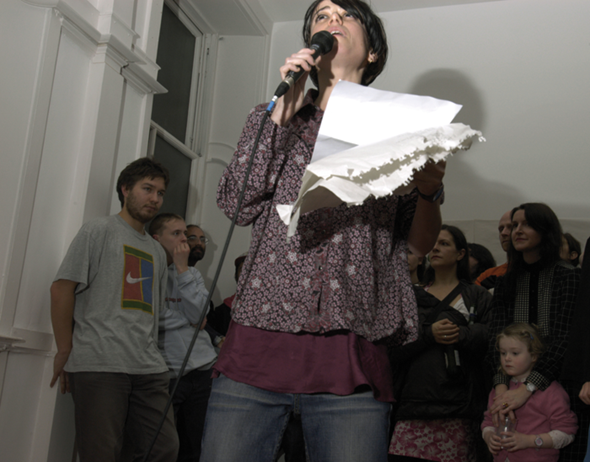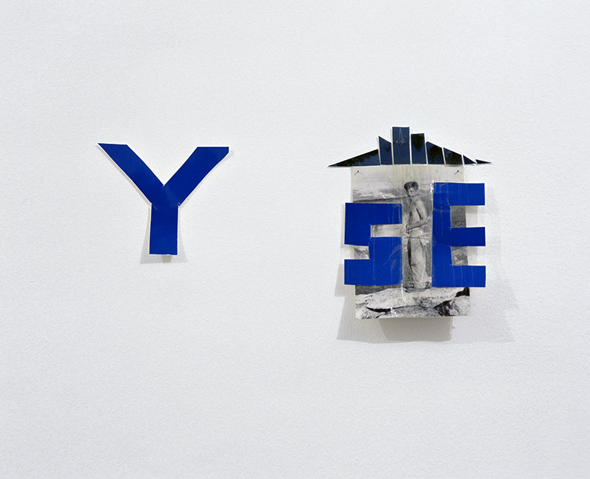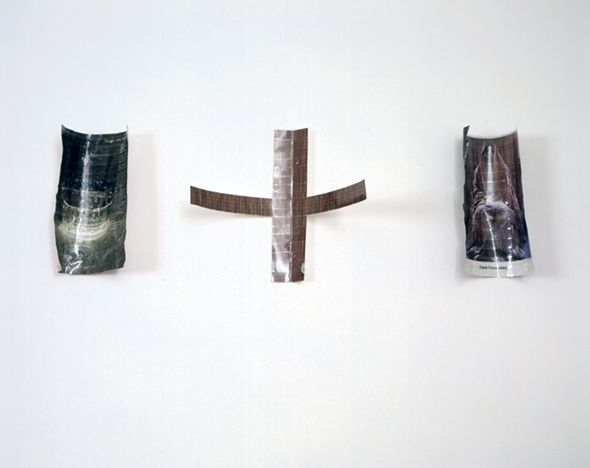
Spoken Words
Scottish artist SUE TOMPKINS adheres to the principle of repetition in her Speech-performances, paper pieces and installations. An interview by JULIEN FRONSACQ
Sue Tompkins is part of the very dynamic Glaswegian art scene that includes Simon Starling, Jim Lambie, Martin Boyce, Joanne Tatham & Tom O’Sullivan, and Lucy McKenzie, among others. Not only did she participate in numerous exhibitions since 1995, she was also part of the very arty band Life Without Buildings, which was made up of artists, writers and curators. Her involvement with this band reflects her polymorphous style of production, developed through works on paper, installations and performances. Each of these resonates with the others. Nevertheless, it appears to be a less a programmatic definition of art than a real attitude. Various fields are linked beyond any vertical construction of culture and a real energy goes through its different parts. The light economy of forms characteristic of her installations, which are made of simple found objects such as a couple of red and blue plastic bottles, is reminiscent of the post-punk music of Life Without Buildings. The works on paper and the lyrics both focus on void and repetition. She uses paper that she folds and writes with repetitive words. The notion of patterns could be emblematic of her aesthetics in music and art. The French meaning of the word »pattern« (dessin) makes explicit a complex work dealing with »construction« and »design«, in other words syntax and musical themes or structure and abstraction. Because Sue Tompkins is engaged in works using language, her sense of conversation reveals a certain distrust of critical simplifications. She seems to insert her work into mechanisms of meaning and imagination as it focuses and dissolves language simultaneously. Making an interview with Sue Tompkins about her work was certainly challenging, but natural.
Julien Fronsacq: You live and work in Glasgow. This city had an artistic development during the 90’s that constituted one of the most impressive historical moments since Charles Rennie Mackintosh (1868–1928) and since the band Simple Minds (laughs). Some Glasgow artists share an interest for history, though in various perspectives. How would you define your relation to Modernism?
Sue Tompkins: I think I try not to or do not really feel that I am defined by any particular relationship to Modernism. I have lived and worked in Glasgow since leaving art school in 1994 and so I sort of feel the city has had an effect on me, the city and living here and the artists that live here too. It is all definitely in the background of my work somewhere.
JF: With whom were you in art school?
ST: In the painting department with my sister artist Hayley Tompkins, Michael Fullerton, Sarah Tripp, Jim Lambie, Mary Redmond, Darren Marshall and lots of others.
JF : What music did you listen to when you were a teenager or in art school ?
ST : Pop, everything, Prince…
JF : Until 2002, you were part of a band called Life Without Buildings with Will Bradley (drums), Chris Evans (bass) and Robert Johnston (guitar). When did you join the band?
ST : 1999.
JF : Did you write the lyrics for LWB?
ST : Yes, I did. The rest of the band did the music. I expressed an opinion about the music, but basically I wrote and sang all the words.
JF: How did you have the idea to start the performances?
ST: I had used performance much earlier though not as a solo artist,or with the band, but I first performed a spoken word piece called Wetness into Music at a gallery called »Wilkes« that the artist Cathy Wilkes ran from her flat. That was my first public performance piece or reading, and it was in 1995. It must have been a conscious decision at the time but I more remember it just being the most natural and inevitable decision to make because I had been writing so much and reading it out seemed the thing to do. I never saw ahead really as to how it would lead to so many other performances in the future.
JF: For many reasons, your performances are quite unique but there are many examples of performances in art history. I think of Schwitters, Hugo Ball, Hulsenbeck, Futurism, Vorticism, Ezra Pound, Fluxus, Yoko Ono. Yoko Ono is one rare example of song-like performances. The radical daily life and very direct poems by Frank O’Hara also come to mind.
ST: I don’t want to define this, really.
JF: Can you explain how you build the texts for your performances? Do you use found material such as lyrics, songs, and literature? Is the montage random or when you set it do you have rhythms, pace and prosody in mind?
ST: No, it’s not random. The words are collected and written over an extensive period of time and then edited to form the final written text, which is not improvised. It is all written down and spoken as written. I look at and take in many forms like music, texts, everyday speech, language patterns, and conversations, but do not directly take from the source. The process is long and always pared down and redefined and particularised over time.
JF: More Cola Wars (2004) has a text structure that evokes a punk song without an instrumental line. Here is an excerpt fromthe piece:
»Play _ play _ play _ play play play _ play play play play play play / Can you see me anymore _ can you see me anymore _ can you see me anymore _ can you see me anymore _ can you see me anymore _ can you see me anymore _ can you see me anymore _ can you see me anymore _ can you see me anymore / I like you _ I like you _ I like you _ I like you I like you I like you / Hey there / I like you_ I like you _ I like you _ I like you _ I like you _ I like _ I like you _ I like you / Mister _ mister _ mister _ mister _ mister _ mister _ mister mister mister mister mister _ mister _ _ mister _ _ mister _ _ etc …«
There is no proper melody but the stresses and the prosody seem to corroborate an immediate and expressive effect. In your performances, you seem to be singing while in Life Without Buildings you had a spoken word style. Each project became complementary to the other. How would you define the relationship between the performances and the works on paper, the typewritten pieces?
ST: The performances come from the very same source as the typewritten text pieces. All the performances are written from hundreds of sheets of typewritten text, which have been ordered and edited into the form that I wish the performance to finally be performed in. A mass, in a sense, leading to a final end point.
JF: As Marinetti theorized, in their declamations, Dada mixes words with sounds, that is to say »direct onomatopoeia« in order to balance abstraction with some realistic brutality1. Your performances attempt to balance abstraction, pop and immediate expressivity?
ST: I agree! I’m not sure it’s balanced though!
JF: How do produce the works on paper?
ST: I use newsprint a typewriter and folding repetitively.
JF: Beyond the use of language, the performances and the typewritten works seem to explore void and architecture, silence and rhythm…
ST: Yes. I would hope they incorporate a real plurality of themes, references and tones.
JF: What is the relationship between the works on paper and the installations?
ST: I set about folding the paper that I type on into a smaller shape so that it can fit in the typewriter and go from there. Often the folding and pleating relates directly to the tone of the text itself, typed onto the sheet… albeit in a very subjective way, I admit!
1 Michael Kirby, Futurist Performance, New York, A Dutton Paperback, 1971, p.32.
JULIEN FRONSACQ is a curator at the Palais de Tokyo, Paris.
SUE TOMPKINS, born in 1971, lives in Glasgow. She has participated in numerous international exhibitions such as the 2005 Venice Biennale in the Scottish Pavillion or Momentum 2006, the Nordic Festival of Contemporary Art (Moss, Norway), Tate Britain (London), Frankfurter Kunstverein, ICA (London), and ARC (Paris).
Represented by THE MODERN INSTITUTE, Glasgow; GALERIE GITI NOURBAKHSCH, Berlin; GALERIE DIANA STIGTER, Amsterdam




